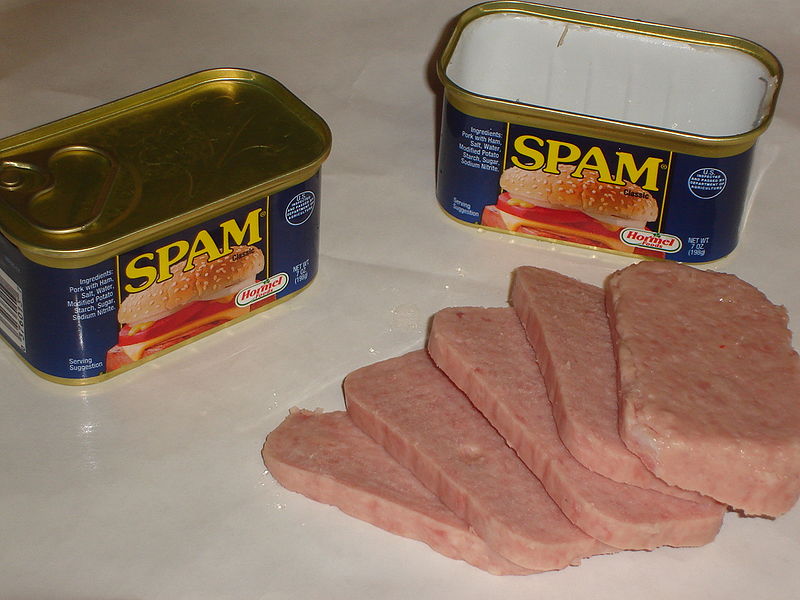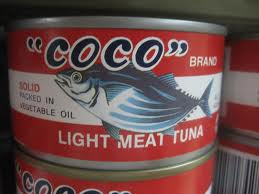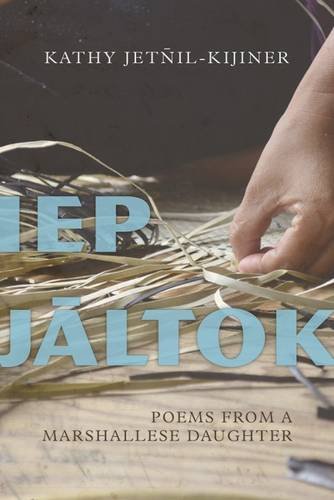This week, I’ll be spotlighting a poem I wrote a few weeks back that centers around two topics: World War II and diabetes.
So how are these two topics linked exactly?
First, let me describe my relationship to diabetes. Like many Micronesians, if I was told to think of my cultural foods, the comfort food that I grew up with, I would immediately think of tuna and rice drizzled with shoyu, or corned beef sizzling hot on a pan with slices of onion and scrambled eggs, or slices of spam that can be dipped in ketchup with a big heaping side of (you guessed it) more rice. In fact, just writing this is making my mouth water.
It wasn’t until I got to college that I was forced to confront these childhood delicious delicacies for what they really are: incredibly unhealthy dishes that has led me and my people down a really dangerous epidemic of diabetes. Don’t believe me? Read this article by Brenda Davis “Defeating Diabetes: Lessons from the Marshall Islands” http://www.todaysdietitian.com/newarchives/072508p24.shtml where she writes:
“Imagine children indulging in popsicles and soda or eating ramen noodles with Kool-Aid powder sprinkled on top for breakfast. Picture families dining on white rice, meat, and sweet beverages for lunch and dinner every day. What kind of meat? How about Spam, canned corned beef, chicken, fish, crab, octopus, and variety meats such as turkey tails or pig intestines?
Where do people eat this way? While our focus here is the Marshall Islands, similar dietary patterns are emerging in impoverished nations throughout the Pacific and around the world.”
First of all – ok I totally cringed when I read this. I mean, way to make it all sound so horrible, like that’s all we ever eat ( I mean yea it’s a lot of what we eat but still). Second of all, don’t yuck our yum ok? KoolAid sprinkled in uncooked ramen is AMAZING. Actually, KoolAid on everything is amazing. But yeah, ok, I’ll admit, she has a point – it’s also outrageously terrible for you. Then she goes on and writes this:
“It would be difficult to design a diet that could more efficiently induce type 2 diabetes than the one the Marshallese people have adopted. Not surprisingly, the rates of type 2 diabetes in this population are among the highest in the world. An estimated 28% of individuals over the age of 15 have type 2 diabetes. For those older than 35, the figure is nearly 50%. Close to 75% of women and more than 50% of men are overweight or obese. Approximately one half of all surgeries performed on the island are amputations due to complications from diabetes. There are no facilities for renal dialysis.
Sixty years ago, diabetes was virtually unheard of in the Marshall Islands. People were slim and physically active and lived off the land.”
This, again, is sadly true, and very depressing to read. We DO have a huge epidemic of diabetes. To be real, one of our Ministers of Health at one point had to go around in a wheelchair because he lost his leg to diabetes. Yup – that says something right there. And because we have no dialysis in the Marshalls, many Marshallese have been forced to leave our home and immigrate here to the Hawai’i and the states to undergo these treatments. In fact, my uncle is one of those people. He’s lived in the Marshall Islands all of his life, in the same house, with the exact same arrangement of photographs and decorations for over 20 years. And now, he can’t even go back to visit his home because he needs treatment from dialysis three times a week. For the rest of his life. Some more heartless people might say – well that’s his fault. He should have known better. He should have taken better care of his health. He should have eaten better.
My uncle’s story isn’t the only story out there. So I found myself wondering – just where did this epidemic of diabetes come from? Why has our culture suddenly come to revolve around canned goods and imported foods? Like Davis writes in her article, “Sixty years ago diabetes was unheard of.” If canned goods was something we were introduced to – just what were those circumstances?
I found my answer in a textbook. As a part of my research, I’ve spent a good amount of time reading more about Marshallese history in the textbook Etto Nan Raan Kein A Marshall Islands History by Julianne Walsh – which you can find out more about here: http://www.yokwe.net/index.php?module=News&func=display&sid=3063
Despite the problems and controversy surrounding this textbook with some Marshallese following its release (don’t get me started on all of that), and despite my obviously biased opinion of it (my mom helped write it and Julie’s like an aunty to me) I’ve found it’s a really useful resource for historical accounts from other riMajel.
The one section which really captured my attention was the section focusing on World War II:
“The period of World War II, from 1941 to 1945, marks a turning point in Marshall Islands history. Marshallese refer to it as “ien pata eo.” During this time, riMajelwitnessed powers, weapons, machines, and violence in ways they had never imagined. Amphibious tanks that could travel on both water and land, airplanes that dropped bomb and after bomb of all types, ships that traveled beneath the surface of the water—all of these things were never seen before in the Marshall Islands. Further, the degree of destruction that they caused made people afraid for their lives and prompted them to wonder what the world would be like after the end of such devastation and madness. Japanese and American soldiers, uninvited and unwanted, fought each other in Marshallese lands, skies, and seas, and there was very little that the Marshallese people could do but try to stay out of the way. ” (249)
This is a pretty good summary of the role of islanders during World War II – just as “observers” and “bystanders” rather than active players in the pacific theater. Always the bridesmaid.
“I learned to picture Marshallese as happy bystanders, singing and cheering elatedly as these victors arrived, hands outstretched to receive chocolate bars and cans of spam—on the sidelines, watching the real world pass them by,”
writes Greg Dvorak in his article, “‘The Martial Islands’: Making Marshallese Masculinities Between American and Japanese Militarism.”
But what really struck me about this section was all the heartbreaking testimonies from rimajel who survived that era, how trapped, helpless and afraid so many of them were. Lautrok Lajikom remembers witnessing the American bombers who arrived at Jobwad, an atoll, and how he ran to the ocean side when he saw the planes and realized they were American bombers, and what happened after the bombs fell on his Arno house:
“When I went back to the house, everyone was lying around. Every one of them. There was no survivor. I remember all of them because I knew them all. They were all my relatives—all of my relatives were dead. The Majuro housing was also hit, but they had dug a hole for hiding. It was not as bad as the Arno house, but it was hit. The [Mile] house, too.”
As the fighting between the Japanese and Americans intensified, life on the atolls grew more desperate and more and more Marshallese along with Japanese were starving.
The treatment of many Marshallese by the Japanese was harsh. One irooj, Lankein, was accused of stealing rice from the Japanese, and Clancy Makroro, a witness to the event, describes the irooj’s punishment.
“They tied his feet and his head and strung him up with a rope and beat him. They beat him and asked him if he was the one, and if he was the one they would stop but, in truth, it was not him. They wanted him to say it was him, and they tried these things so that he would beg them to stop beating him. The Japanese themselves stole the rice, and they lied about the chief so that he would be hurt.” (266)
Marshallese weren’t allowed to leave the atoll even for fishing, because the Japanese were worried about traitors (it was this little morsel of information which ultimately inspired my poem). There were bans on fishing at night. Imagine not even being able to sustain yourself throughout these periods of starvation through the use of a skill you’ve always had: fishing.
The Japanese fear was so great that even family members who had been left behind by Marshallese deserters were severely punished:
I also got to read about my jimma Carl Heine, who was of German ancestry and, because he spoke English, was also executed by the Japanese. And his son, John Heine, was forced to flee and live in the outer islands in secret, hiding out from the Japanese until the Americans came. This is a story I’ve heard from my mother many times before- I even wrote a short story based on his bravery back in middle school. I always knew about World War II, but learning about it from a Marshallese context made it really hit home, made me angry that we islanders who had nothing to do with this war were forced to bear such hardships. And that our stories are completely left out in history.
The history which led up to these points (the previous chapters) were almost boring in comparison with this chapter. The life of rimajel before World War II was so peaceful. I guess I was just being naïve, or just ill informed. But reading these hardships the rimajel had to endure filled me with so much sadness for my peaceful ancestors who were pawns in this global catastrophe of a war.
But I guess you’re wondering where diabetes comes into play in all of this. Well, enter the Americans – who liberated the Marshallese with what rimajel from the past remember as “towers and towers of food” – piles of food (K-rations) bigger than the buildings.
Imagine starving for months, bearing horrifying abuse and death after death, witnessing the power of bombs and weaponry you’d never seen before. And then all of a sudden – there’s all this food. From the Americans.
Call me crazy, but I personally have a theory that we riMajel, especially those generations who lived through World War II, are suffering from major issues of post traumatic stress disorder, and that many of our elders never really got over those intense periods of trauma. That’s why they (and as a result we) keep eating these types of food. This food became associated with liberation from fear, from death and from starvation. And they’ve held onto these associations, these destructive eating habits for so long that they were never able to let it go – and as a result, they’ve passed this type of eating to the next generation as well. To my generation. We eat these foods because they taste good to us, because it’s what our family eats. I don’t think of the fat clogging my arteries when I eat this food. I think of coming home after school, talking story with my dad while spam sizzles on the pan. I think about sharing biscuits dipped in carnation milk with my grandma, Bubu Namiko as she giggles and tells me that it’s her favorite. I think about fishing out on the lagoon at night (again with my dad), and eating scoops of tuna and rice while we wait for the fish to bite.
I’m not saying that we don’t hold any responsibility for this epidemic of diabetes. Of course we do. Many of my family members have eliminated white rice from their diets, and are limiting their reliance on canned foods, and are proponents of eating locally grown food instead. So yes, we need to take responsibility to change our lifestyle and our reliance.
It’s just that I also want people to know and acknowledge that there’s also a history of trauma which is embroiled in this type of eating, and that this history can’t be ignored. Whenever we discuss diabetes, a lot of the talk I hear is all about blaming Marshallese for just being indulgent, fat, and too lazy. But if we really take a step back and look at the bigger picture, we’ll see that there’s more to it than we realized. We’ll see that there’s this awful history of war, death, starvation and of course – colonization. These eating habits didn’t just arrive out of nowhere. Canned food didn’t just rain from the sky.
Or did they?
Hooked
I.
After he felt the rain of bombs
that left puddles of silver shrapnel, slivers of
splinters where houses once stood and charred
bodies – both japanese and marshallese –
After he watched soldiers shoot
a woman’s ears off
because her husband
was a deserter, an accused traitor,
After he watched his chief, strung up
by his ankles, beaten raw for stealing
from a dwindling supply of coconuts,
After fugitive nights, when fishing was banned,
when he’d slip onto the reef flat, breathless,
the moon curved, shining like
the outlawed fishhook, gripped tight
between his fingers
And after nights when even this
became dangerous, after the children
stopped asking for his stolen catch of fish,
after even they had withered away,
rows of ribs smiling
grotesque grins through skin
II.
After all of that
it must have seemed
heaven sent
a gift from God
this gift from the americans,
this shining tower
of food
placed before him
box after box after box
of canned spam, flaky biscuits
chocolate bars, dry sausages, hard candy and
bags and bags of rice all waiting
to be eaten
He remembers
he cried
it was so
beautiful
III.
Every day of the life he led after he remembers
that pile of food taller
than any building he had ever seen
He remembers it as he pops
open a can of vienna sausage, savors
the salty grease on his warm rice, the taste
of a filled belly
He remembers it as he slices spam, sizzling
hot on the pan, he remembers it
as he drizzles soy sauce
into a boiling pot of crispy ramen
IV.
And even after
his breathing
turns heavy
even after his joints protest the walk to the store
even after
the devious tingle trickled into his arms, even after
the doctors told him the leg
would have to go,
even then
he never
stopped
licking the grease
from his fingers
that still felt haunted
by the outlawed
hook.
V.
When his children asked him why
he wouldn’t, couldn’t listen, why
he kept eating the food his doctors
had prescribed against, even after
they begged
he merely
flexed
his restless
fingers.
He had been hungry.
He would never be hungry again.



Elap an eman entry kein am. Ikar jaje ke ewor Marshallese poet. Kwo kanuij in kapeel im meletlet. Jeramõn ñan kwe im paamle ne am.
You’re a true inspirational to anyone who read all your remarkable entries.
Wow! Elap unin bwe in kamolol Anij kin yuk Kathy! Ejelok ao bere lok wot nan jidrik ke kwoj likit Anij imaan men otemjej kin ke kabeel im jelalokijen rej itok iumin karok im bebe eo An wot!! Mekar ta ne kwoj jab jela kajjeo im bolen koban jela kajjeo ak ilo ao read i jerbal emanman kein am ij loe ke kabeel im jelalokijen rej bed ibbam. Kommol kin am kojerbal kabeel ne am im na ainikied woj riMajel. Inej kememej wot yuk ilo JAR!
This is just a POWERFUL piece Kathy! Keep writing!
Anij ibbam im family ne am!